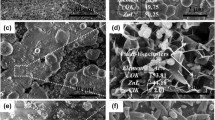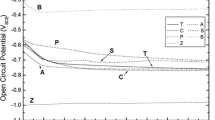Abstract
Electrochemical migration (ECM) is a potential reliability problem in electronic soldering which might become more dangerous in lead free electronic devices. In this paper, electrochemical migration tests on Sn-Pb and lead free solder alloys were conducted under distilled water by applying constant voltages with a power supply. The susceptibility of the solder alloys to ECM and the effect of the composition on ECM behavior were studied. It is found that both Sn-Pb and lead free solders investigated in present research have susceptibility on ECM. Dendrites grow from cathode to anode and show different morphologies with the different migration elements involved. In Sn-37Pb and Sn-36Pb-2Ag solders, the main migration element is Pb. While for Sn-Ag and Sn-Ag-Cu solder alloys, Sn leads the migration. For Sn-8Zn-3Bi, both Sn and Zn can migrate. Furthermore, the effect of applied voltage on the time to short and short resistance was also investigated. As could be expected, the higher the voltage is, the shorter the failure time is. The electrochemical migration mechanism of the solder alloys was also discussed.
Similar content being viewed by others
References
Harsanyi, G., IEEE Trans Comp., packag., Manufact. Technol. A, 18, 602 (1995)
Harsanyi, G., Microelectronics Reliability, 39, 1407 (1999)
Takemoto, T., Latanision, R. M., Eagar T. W., Matsunawa, A., Corrosion Science, 39, 1415 (1997)
Warren, G. W., Wynblatt, P., Zamanzadeh, M., Electron J., Mater. 18, 339 (1989)
Abtew, M., Selvaduray G.: Mater. Sci. Eng. R. 27, 95 (2000)
Wu, C. M. L., Yu, D. Q., Law, C. M. T., Wang, L., Mater. Sci. Eng. R. 44, 1 (2004)
Coleman, M. V., Winster, A. E., Microelectronics Journal, 4, 23 (1981)
Jachim, J. A., Freeman, G. B., Turbini, L. J., IEEE Trans Comp., packag., Manufact. Technol. B, 20, 443 (1997)
Benson, R. C., Romenesko, B. M., Weiner, J. A., Nall, B. H., Jr H. K., Charles, IEEE Trans. Components, Hybrids, Manuf. Technol. CHMT-10, 363 (1988)
Dumoulin, P., Seurin, J. P., Marce, P., IEEE Trans. Components, Hybrids, Manuf. Technol. CHMT-10, 479 (1982)
Harsanyi, G., Inzelt, G., Microelectronics Reliability, 41229 (2001)
Katayanagi, H., Tanaka, H., Aoki, Y., Yamamoto, S., ESPEC TECHNOLOGY REPORT, 9 p15-20
Brusic, V., DiMilia, D. D., Maclnnes, R., Corrosion, 47, 509 (1991)
Xia, Y. Y., Utility handbook for experimentalist (Chemistry Engineering Press, second version, 2005) p.648
Steppan, J. J., Roth, J. A., Hall, L. C., Jeanotte, D. A., Carbone, S. P., J. Electrochem. Soc., 134, 175 (1987)
Author information
Authors and Affiliations
Corresponding author
Additional information
The author is now at Fraunhofer IZM, Berlin, Germany
Rights and permissions
About this article
Cite this article
Yu, D.Q., Jillek, W. & Schmitt, E. Electrochemical migration of Sn-Pb and lead free solder alloys under distilled water. J Mater Sci: Mater Electron 17, 219–227 (2006). https://doi.org/10.1007/s10854-006-6764-0
Received:
Accepted:
Issue Date:
DOI: https://doi.org/10.1007/s10854-006-6764-0




